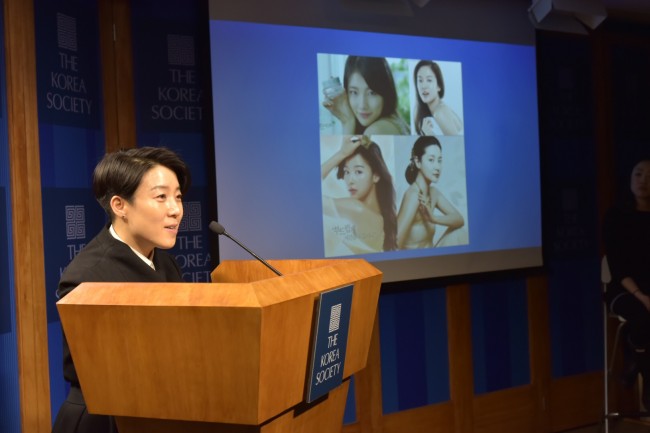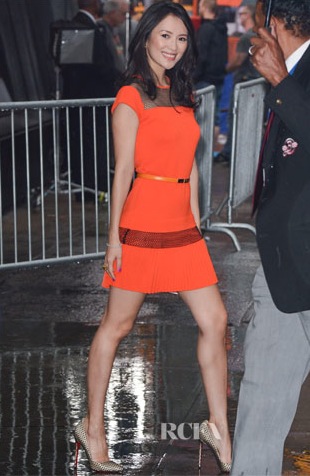by LISA WONG MACABASCO
If you’ve ever flipped through a Korean fashion magazine or tuned into a singing competition on Korean TV, you’ve seen models and singers donning elaborate, dramatic makeup. Take K-pop singer Hyori Lee, known for her glam, sexy style and bold use of colors, and 2NE1’s CL, who sports an edgy look and favors darker shades of makeup.
But a more natural look is coming into vogue, especially among Korean actresses, said makeup artist Seong Hee Park during a talk held late January at The Korea Society in New York City.
During her hour-long talk entitled “Images of Korean Female Beauty,” Park, an 18-year veteran of the fashion industry, explained how the standards of Korean beauty have origins in the use of more natural shades to accentuate, rather than exaggerate, one’s features, so as to make it appear as if one wasn’t wearing makeup at all.
This emphasis on naturalness, Park said, is part of a long tradition in Korea that dates as far back as the Joseon Dynasty.
“Personally, I believe that the natural hair and makeup portrayed by actresses in Korean dramas and movies better represents Korea’s beauty rather than the more dramatic, sexier appeal of today’s K-pop girl groups that have largely been influenced by Western pop culture,” Park said, speaking through an interpreter at the Jan. 28 event.
The boyish, petite Park, who wears her hair shortly cropped and has bright, clear skin, is a native of South Korea who has lived in New York for the last six years. Speaking at The Korea Society before a small audience, she came dressed in a modern black suit over a white shirt. A silver earring dangled from her left ear and she wore a stud in her right ear.
 Seong Hee Park during at The Korea Society in NYC. (Photo courtesy of Thomas Kung).
Seong Hee Park during at The Korea Society in NYC. (Photo courtesy of Thomas Kung).
Park has created looks for the K-pop group Wonder Girls and actress Yunjin Kim (of the hit series Lost), and has collaborated with international makeup artist Pat McGrath for such events as the Met Costume Institute Gala, the Council of Fashion Designers of America Awards and fashion weeks in New York, Paris and Milan. Park’s looks also have been featured in fashion magazines around the world, including i-D Magazine, Vogue Korea, W Korea, Harper’s Bazaar Korea and Elle Korea.
Although Park acknowledged the popularity of plastic surgery among many Korean female celebrities, she said many Korean actresses today favor embracing one’s natural features, including Yeong-ae Lee from the Korean historical drama Dae Jang Geum; Ji-hyun Jun from the fantasy romance TV series My Love from Another Star; Hye-kyo Song from the drama Autumn in My Heart and film Hwang Jin Yi; and Su-ji “Suzy” Bae from the K-pop girl group Miss A.
During the Joseon Dynasty period between 1392 and 1897, inner beauty was prized over outer beauty, said Park. As a result, women favored simple styles during that era, for instance parting their hair down the middle and wearing similar styles of hanbok so as to not stand out.
Makeup styling during this era was one way to discern differences in status and rank, she said. For instance, lower-ranking women wore heavier makeup, such as thick powder, red lips, blushed cheeks and defined eyebrows. Women from the noble class wore a thin layer of powder and a light application of makeup on their eyebrows on a daily basis. These women reserved more defined makeup for special occasions such as rituals, outings or entertaining guests at their home. Bright, clear skin defined the ideals of beauty, while a clear, lighter complexion symbolized nobility, Park said.
To illustrate how beauty was defined during that era, Park referenced the Joseon-era artwork Mi In Do (“Portrait of a Beauty”) by the late-18th-century Korean painter Shin Yun-bok.
“Women of the Joseon Dynasty had a healthy, more voluptuous shape, [and] thick black hair and soft expressions,” Park said. “They had small, cherry red lips; thin eyebrows like crescent moons; slightly slanted eyes without any creases or folds; a small nose like a single piece of garlic; and a wider forehead. Although they did apply a bit of makeup to their eyebrows, cheeks, and lips, it did not overpower, and maintained their natural complexions within the limit of the natural shape.”
The current trend towards natural and organic beauty products in Korea also has a history steeped in tradition, Park noted. Korean women dyed their nails with bongseonhwa flower petals long before the invention of nail polish, she said, while women in the Joseon era created beauty products from products like beans, milk and eggs.
Alicia Yoon, founder and CEO of the New York–based Korean beauty retail site Peach and Lily, agrees that the current trend in Korea is to look more natural. “The ‘no-makeup makeup’ look is what women strive for,” Yoon said. “The ideal look, as propelled by Korean popular culture and media, is flawless, youthful, radiant skin with slightly flushed cheeks and dewy pink or peach-toned lips. Smoky, dark eyes or darker-hued lips are not as much en vogue today in Korea.”
Although beauty trends have come and gone in Korea, Korean celebrities are gradually moving towards showing their most natural selves, Park said. “Like the woman in Mi In Do, Korean female stars still try to enhance, not hide, their most natural beauty by applying natural makeup that always leaves people wondering [whether] they are or are not wearing makeup,” she said.
___
Photos courtesy of Thomas Kung









